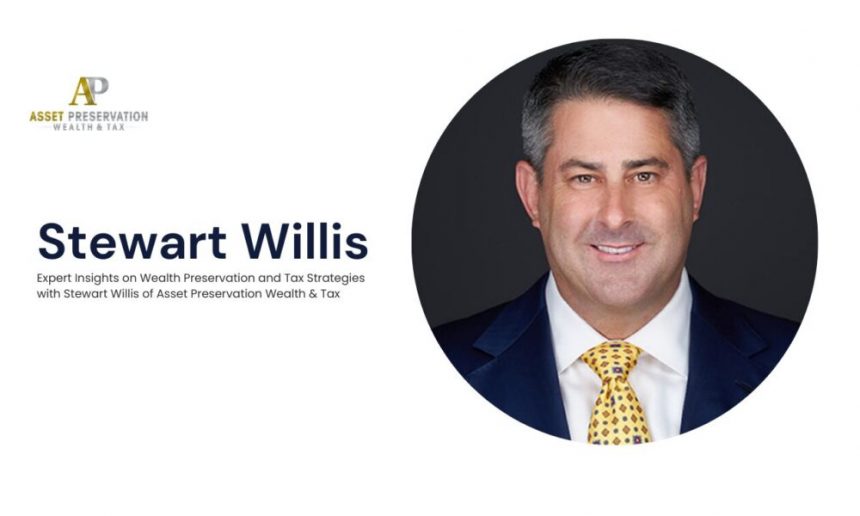Understanding how to safeguard and grow your wealth is critical. Stewart Willis, co-leader of Asset Preservation Wealth & Tax, shares his insights on navigating economic volatility, optimizing tax strategies, and preparing for life’s unexpected turns. With roots in estate planning and years of financial expertise, Willis and his team specialize in serving middle-market investors; individuals and families who have worked diligently to build substantial assets without the cushion of generational wealth.
In this interview with TechBullion, Stewart Willis shares strategies to maintain portfolio stability during turbulent market periods, the importance of taking advantage of historically low tax rates before they potentially expire in 2025, and how proper planning can lead to long-term tax efficiency. He also highlights the necessity of balancing risk and reward, building liquidity to handle unforeseen financial shocks, and ensuring investments align with personal risk tolerance.
Whether addressing market corrections versus crashes or inflation’s stealthy erosion of wealth, Willis emphasizes the importance of staying the course, making data-informed decisions, and planning holistically. His practical advice provides a roadmap for individuals looking to secure their financial future while navigating complexities like varying state tax laws and evolving retirement policies. This conversation is a must-read for those seeking clarity and confidence in their wealth management journey.
Please tell us more about yourself and what you do.
My name is Stewart Willis and I grew up in San Diego and attended the University of California at Berkeley, where I was on the California crew team. During my time there, we won a Pac-10 Championship, even beating the University of Washington, which was a big highlight. Originally, I planned to go to law school, but I ended up finding my way into finance. I started from an estate planning angle, working with people on setting up their estate plans, and eventually transitioned fully into finance.
Asset Preservation was actually founded by a good friend of mine, Paul Mumford, who sadly passed from unforeseen circumstances. We took over the company in 2008, and since then, it’s grown from a single, local office into what we have today—11 locations, soon to be 12 with the opening of an office in Vancouver, Washington. We’ve really focused on maintaining that local feel despite the growth. The reason we’ve been able to expand is because we serve an often-overlooked market: the middle-market investor. These are people who don’t come from generational wealth or have a household name but they’ve worked hard, saved, and built something substantial. That’s who we’re here for.
With increased stock market volatility, many investors feel uncertain about their portfolios. What key strategies do you recommend to your clients to safeguard their wealth during these unpredictable times?
The first thing I tell clients is to really understand the risks in their portfolios—especially the risk of changing their tolerance based on the ups and downs of the market. When things are good, everyone wants to be aggressive, but as soon as the market dips, they want to go conservative. It’s natural, but it ends up being like hitting the gas and then slamming on the brakes over and over. Instead of trying to time the market, which is incredibly tough, we focus on time *in* the market. Studies show that missing even a few of the best days can have a huge impact on your returns. So, I encourage clients to stay invested at a level that feels right for them and let those key market days work to their advantage. It’s all about consistency.
Recent changes in tax policy have raised questions for individuals and business owners alike. How should investors adjust their financial strategies to accommodate new federal or state tax laws that might affect their portfolios?
Right now, we’re in a unique period where middle-class taxpayers can benefit from historically low tax rates under the Tax Cuts and Jobs Act. While some say it only benefits the ultra-wealthy, that’s not really the case. A lot of our clients are in the 12-24% tax brackets, where there’s a huge opportunity for savings. This window is set to close at the end of 2025 unless Congress steps in, so it’s smart to take advantage of it while we can. We’re encouraging clients to pay taxes now, while they’re ‘on sale,’ and put those funds into tax-free retirement accounts, like Roth IRAs. Even though you don’t get an immediate tax break, it allows your money to grow tax-free for years. When you retire, you won’t have to worry about taxes, and when you pass it on to your kids, they won’t either. It’s all about planning ahead to make the most of this window.
With corrections in the stock market becoming more common, how can investors strike a balance between risk and reward in their investment strategies while preserving long-term growth?
The first step is knowing your own risk tolerance. Many people don’t fully understand how much risk they’re comfortable with until they go through a proper risk-tolerance review with an advisor. We use tools like Morningstar, Nitrogen, and Kwanti to analyze portfolios from multiple angles and see if they truly align with a client’s comfort level. Often, we find that people are taking on more risk than they realize. This can happen because when markets are soaring, like the S&P’s recent 40% rise, people tend to feel more aggressive. But it’s crucial to keep a steady balance and not let short-term gains overshadow long-term risk.
Specific tax laws can sometimes create complications for high-net-worth individuals with multiple residences or businesses. How do you help clients navigate the complexities of these varying regulations to maximize tax efficiency?
When you have multiple residences or businesses in different states, tax laws can get really complex, especially for high-net-worth clients. We help by first clarifying where you’re actually a resident, so you don’t get hit with unexpected taxes—states like California, for example, are known for being quite aggressive about claiming tax revenue and will dig into your property ownership, time spent in the state, and even your phone records. For clients who live near state borders, we often explore dual-state strategies. Take Washington and Oregon, for example: living in Washington means no state income tax, while you can take advantage of Oregon’s lack of sales tax for big purchases. It’s a smart way to optimize costs across borders. We take a big-picture approach and work closely with legal and tax professionals to ensure everything is compliant but also efficient. Ultimately, it’s about designing a tax strategy that works with your lifestyle, so you’re maximizing tax efficiency without any surprises.
With rising inflation and changing interest rates, many investors are concerned about the long-term impact on their wealth. What are some of the proactive steps you advise to protect and grow wealth in such an uncertain macroeconomic environment?
The key is finding the right balance of risk. First, ensure you’re at a comfortable risk level—but don’t be overly conservative either. A common mistake is selling when the market is low due to fear, which leads to missed opportunities. By avoiding the equity markets entirely, you risk leaving potential long-term growth on the table. Staying invested with the right level of risk allows you to weather fluctuations while still positioning your portfolio for growth. Just make sure you’re prepared for the ups and downs along the way.
Natural disasters and other sudden events can wreak havoc on personal finances and investments. What role does wealth management play in helping clients prepare for and recover from such unforeseen financial shocks?
The first thing is to know the risks of where you live. In places like Nevada, Arizona, and Portland, natural disasters aren’t as common, but it’s still smart to have an emergency fund. Having cash on hand that’s safe from market ups and downs gives you the flexibility to handle any issues right away. A lot of people want every dollar to be working, but sometimes your money is ‘working’ by being liquid and accessible. With today’s higher interest rates, you can still earn around 4.5-5% in a money market account, which is even outpacing inflation. So, having cash ready means you’re covered for the unexpected without waiting on slow insurance payouts or scrambling for funds.
There is often confusion between a market correction and a full-blown crash. Could you explain the differences between these two scenarios and how investors should respond to each?
A market correction and a crash are both drops in the market, but they’re pretty different in size and impact. A correction is usually around a 10% drop from recent highs, and it’s actually pretty common—almost like the market taking a breather. Corrections can happen because of economic news, global events, or just shifts in investor mood. They’re usually short-lived and can even be good buying opportunities if you stay steady. A crash, on the other hand, is a much steeper drop, often 20% or more, and tends to come on suddenly. Think of the financial crisis in 2008 or the COVID selloff—crashes are usually triggered by big, unexpected events and can really shake up investors. For both situations, the best thing is often the same: stay focused on your long-term goals and avoid making impulsive decisions. Selling during a drop can lock in losses and mean you miss out when the market bounces back. Keeping a portfolio that fits your risk level helps you ride out these ups and downs and stay on track. Market dips are just part of the journey.
Tax law changes can significantly impact retirement planning. What specific adjustments should investors consider to maintain tax efficiency in their retirement portfolios amid shifting tax policies?
The main point is to act now on what we know: current tax rates are low, providing a unique opportunity under the Tax Cuts and Jobs Act. Many people put off tax planning, but with this tax window ending in 2025, it’s essential to take advantage now rather than waiting for possible future changes. While some hope the cuts will be extended, that’s unlikely given the economic shifts since 2017. Instead of waiting on “what ifs,” investors should focus on the current opportunity to secure tax efficiency in their retirement portfolios.
Inflation is often a silent wealth eroder. What are some innovative strategies you’ve implemented to help your clients preserve their wealth during periods of high inflation, fluctuating interest rates, and trade disruptions? What holistic approach do you take when advising clients on wealth preservation and growth in such a dynamic environment?
Inflation can quietly chip away at wealth, so we use a few key strategies to protect our clients. First, we look at assets that tend to keep up with inflation, like real estate, commodities, and infrastructure, which can offer some cushion as prices rise. We also diversify across different sectors, focusing on areas that hold up better during inflation, like healthcare and consumer staples. And for cash holdings, we use high-yield money market funds so cash isn’t just sitting idle. Our approach is holistic—we’re not just looking at investments but also factoring in tax planning and income needs to make sure clients’ wealth is protected and positioned for growth, even in a shifting economy.








